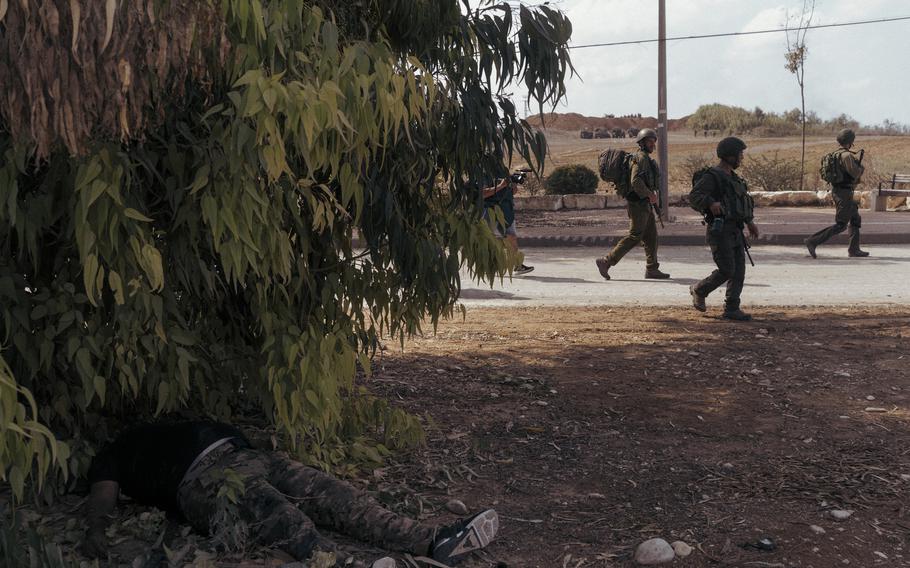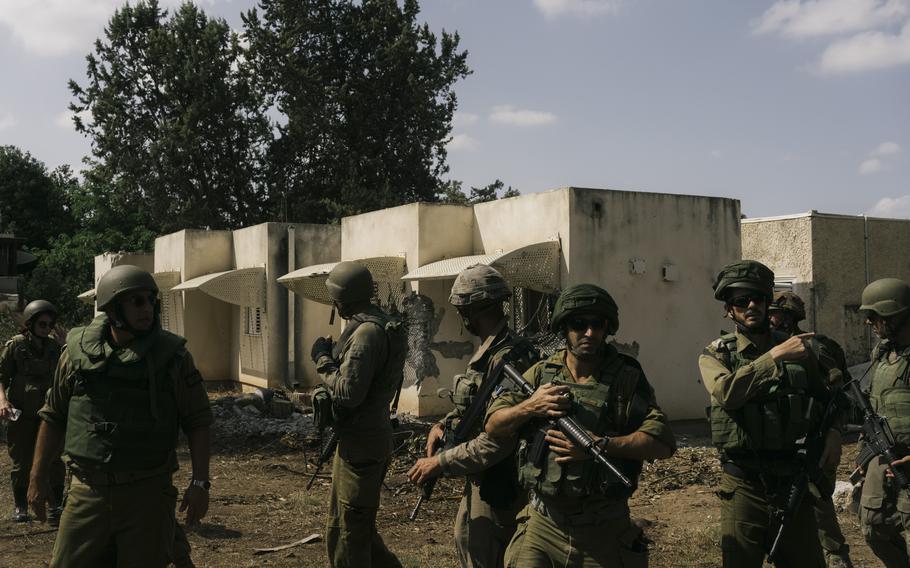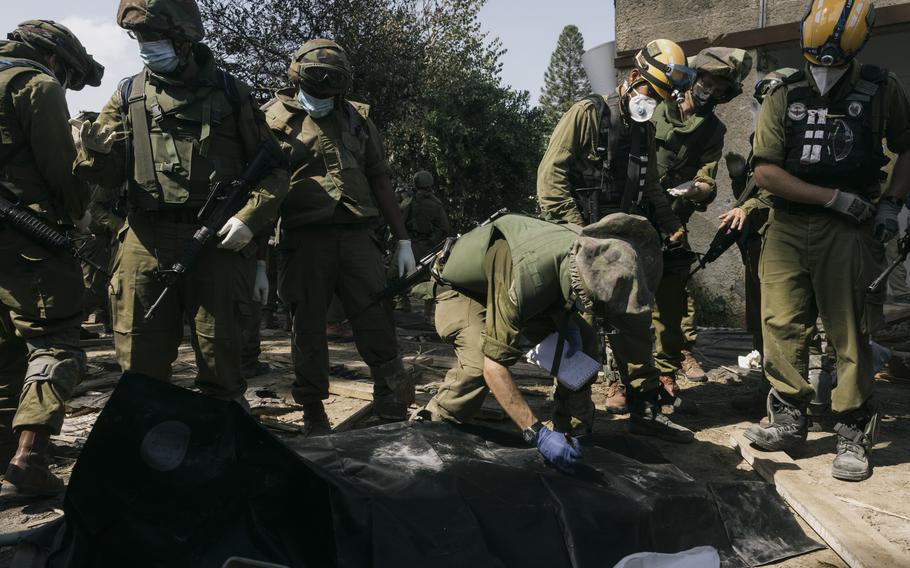
Israeli soldiers walk past the dead body of a militant in Kfar Azza, Israel, on Tuesday, three days after Hamas attacked the town. (Lorenzo Tugnoli/The Washington Post)
KFAR AZZA, Israel — The entrance to this small farming community was lined with bullet-riddled cars, paved with shattered glass and flanked by two dead Hamas fighters. A cluster of Israeli soldiers squatted by one of the bodies, their weapons trained toward a distant ridge and the sound of machine gun fire.
Military officials said the village was finally secured late Monday after 2 1/2 days of intense fighting. But with regular explosions overhead and black plumes of smoke rising above the Gaza Strip just over a mile away, the battle felt far from over.
The Israeli army escorted a group of journalists inside the town early Tuesday as the recovery of bodies was beginning. The pastoral community of about 400 is one of the closest to Israel’s sophisticated border fence with Gaza, which Hamas militants breached with apparent ease Saturday before rampaging through town after town.
The burned homes and crushed cars here were surrounded by unmarked fields and groves. Water poured down the slope from a busted main.
Kfar Azza was still off limits to the residents who had time to flee. So many didn’t survive the shocking invasion, which shattered the peace of a weekend morning so suddenly that full cups of coffee and a jug of milk still sat on the table in one kitchen. The floor was smeared with blood.
Outside, the air was heavy with the smell of smoke and death. Many of these low, boxy houses contained more bodies, said Maj. Gen. Itai Veruv — those of slain residents and perhaps more of their attackers. He couldn’t say how many.
“We don’t know yet,” Veruv said. “It is a big massacre, a catastrophe.”
Veruv was the commander of the huge defensive operation that the Israel Defense Forces scrambled to mount after being caught badly off guard on the last day of the Jewish Sukkot holiday. He was officially retired until he heard the news, just after dawn, that villages in the south had been overrun.
By 9 a.m., he was in the area, where he stayed for three days, bearing witness to the worst scenes he has seen in 40 years of service. “I never saw anything like this,” he said. “I never imagined.”

Israeli soldiers search Kfar Azza on Tuesday. Military officials said the village was finally secured late Monday after 2½ days of intense fighting. (Lorenzo Tugnoli/The Washington Post)
On the Gaza side of the compound, a section of the steel fence had been wrenched free, the entry point for at least some of the Hamas fighters. Israeli soldiers were posted on rooftops and between houses, all staring toward the Palestinian enclave.
The soldiers have tried to understand how the attack unfolded by looking at the bullet scars on the wall, and the pattern of a dozen dead infiltrators whose bodies still lay on lawns and sidewalks — among some 1,500 bodies of Palestinian militants the military says it has found across Israel. There was a crashed paraglider near a bus stop where one of the gunmen had descended from the sky. One of their motorcycles lay on its side near a pickup truck with shattered windows, its emergency lights still flashing.
The town’s small security squad — residents with guns — gathered toward the western edge of the compound when the attackers came, Veruv said. He pointed out a block of houses they called “the baby section,” because of all the young families who lived here. Those who were armed clearly fought, the soldiers said, but many didn’t survive.
Most of the vehicles in a sandy parking area were heavily damaged, with bullet holes and broken windshields and doors twisted out of shape. The infiltrators apparently went down the line, looking for cars to steal. “They wanted a way to take hostages,” one soldier said.
Every few minutes, explosions shook the bright sky — mostly air defense missiles intercepting the rockets that Hamas continues to launch from Gaza. Beneath the booms, an army mortuary unit moved through the devastation.
One team loaded white body bags into the back of the truck. Another worked with six black bags, some with the Star of David, gathering them in the shade of a tree. At the entrance to the kibbutz, a crowd of Orthodox volunteers wearing yarmulkes, rubber gloves and safety vests waited to make sure all remains had been collected, a requirement for Jewish burial.
Some civilians still lay where they fell. Behind one house, a woman with bare feet and red pants had been covered with a cloth; a man in shorts was in the stream of water from the damaged main.

Soldiers recover the bodies of civilians who died during the Hamas attack in Kfar Azza. (Lorenzo Tugnoli/The Washington Post)
The soldiers had yet to sweep every house. It was still possible that some survivors were in hiding places or safe rooms, Veruv said.
The process was slow. Soldiers warned the journalists to watch out for booby traps — they had already found some — and unexploded ordnance.
“There’s a grenade there. Step back!” a soldier shouted as reporters approached one yard near where a Sukkot holiday hut was collapsed and broken.
A column of troop carriers rolled into the compound, and then another one. A tank rumbled past the farm equipment that sat idly at the edge of a field. Israel was reinforcing its hold on a community that, for days, it had lost. The IDF said Tuesday that it was increasingly confident that the area was secure, and that its forces were preparing to go on the offensive against Hamas.
Veruv said he would not be going back into retirement anytime soon.
“Now we will fight,” he said, “and I think we will fight for a very long time.”